Zinnias are prolific annual flowering plants that come in various colors and shapes. They are easy to grow and perfect for beginners (or who like to enjoy healthy gardens but don’t want to spend too much time and effort on them) and adapt to various conditions. If you are looking for something to add bright color to your garden, consider planting zinnias. You can find varieties for any landscape solutions: from low growing to tall, there is something for any taste.
These annuals will grow for one season and produce seeds within a couple of months: if you like them, you can try to propagate for the following year. Under optimal conditions, these plants will produce voluminous flowers that will attract plenty of pollinators (including bees and butterflies), making your garden more lively and attractive. The blooms resemble daisies and grow on erect stems: they are perfect for cutting flowers. Consider using them in bouquets or other compositions to add an elegant touch to your house.
Additionally, zinnias are the optimal solution for plants that struggle with pests or that need some help to pollinate: consider adding them as companions plants to keep your yard healthy. But can zinnias grow in part shade? And what can you do to recreate the optimal conditions for their development and get the most out of these stunning plants? Keep reading to find out!
Can Zinnias Grow in Part Shade
Let’s go straight to the core of the question. Ideally, zinnias need full sun to thrive. After all, to support their voluminous bloom production, they need plenty of energy. However, if you live in a warm region, you might have no issues growing your flowering plants even in partial shade.
Of course, to be successful, you’ll need to meet these plants’ requirements. Also, keep in mind that growing zinnias in partial shade might cause discoloration, reduce flower production, and make your plants more susceptible to diseases. In particular, this plant is prone to powdery mildew, a fungal infection that thrives in cool and moist areas with poor air circulation).
In short, you’ll have much better results when planting your zinnias in full sun. But if you can only offer partial shade, make sure your plants receive at least a couple of hours of sun in the morning.
Keep in mind that these plants are native to Mexico, meaning they prefer warmth and don’t mind bright, direct light. If you live in a northern region, ensure you plant your seeds after the last frost date. Luckily, these plants get to maturity fast: in about eight to twelve weeks, you’ll be able to enjoy your zinnias. To learn more about taking care of them, jump to the next section, where we included our tips and recommendations to get the most out of your zinnias.
Zinnias Care: Our Tips
If you can provide your zinnias with what they need to thrive, you won’t have to worry too much about them.
These plants do best in the southern parts of the country. Indeed, zinnias are sensitive to frost and won’t grow at temperatures below 60F. Besides selecting a location with adequate sunlight (as we explained in the previous section), you must ensure your plants get proper air circulation and nutrients.
For best results, plant them in rich, well-draining soil. Ideally, the pH should be between 5.5 and 7.5. Carry out a soil test to know whether you’ll need to make amendments or not. Consider adding compost to the ground to boost flower production and improve drainage and water retention. Don’t forget to add mulch around your plants (especially if you live in a warm region): it will help regulate the soil temperature and maintain your plants moist for longer.
To minimize the spread of diseases, prune your plants when they reach three inches tall. Proper air circulation is essential to avoid severe fungal infections that might damage your plant (or even kill it).
Maintaining your zinnias isn’t demanding: keep the soil moist and fertilize it to maximize flower production. To encourage more blooms, consider practicing deadheading: cut off the old flowers to make space for new growth.
Can Zinnias Grow in Part Shade?: Conclusion
Don’t forget that zinnias are annual plants: if you’d like to enjoy them the following season, allow the last flowers to mature and scatter their seeds after the last frost.
Related Article: Zinnia Companion Plants

